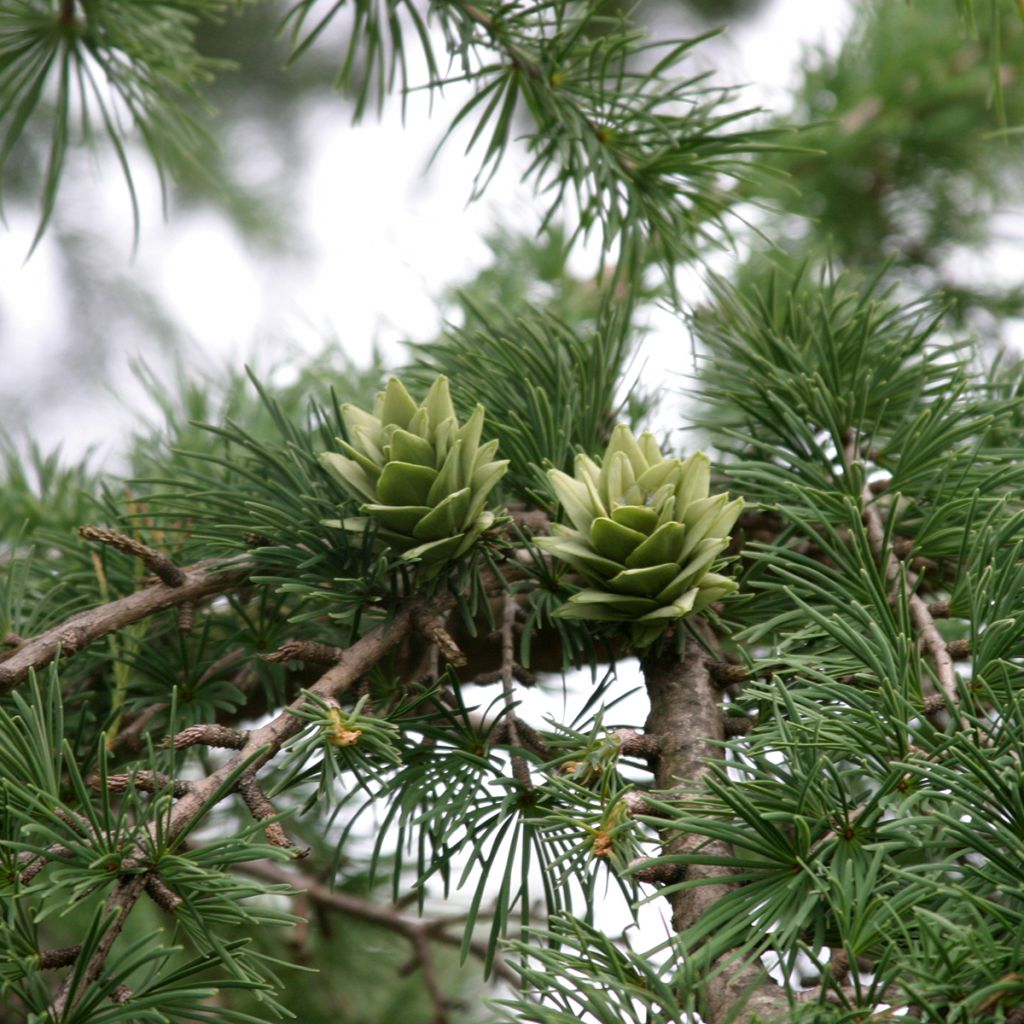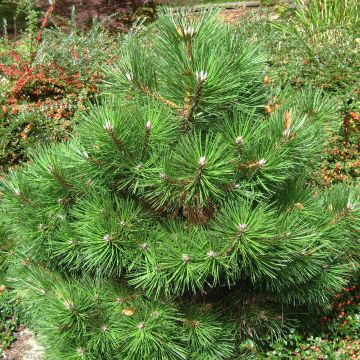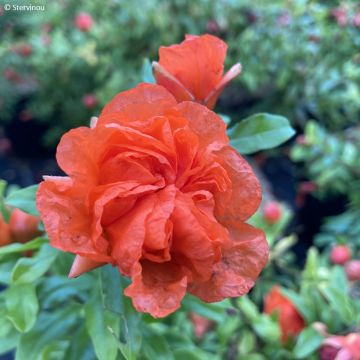

Pseudolarix amabilis - Golden Larch


Pseudolarix amabilis - Golden Larch
Pseudolarix amabilis - Golden Larch
Pseudolarix amabilis
Golden Larch, Chinese Golden Larch
This item cannot be shipped to the selected country
Delivery charge from €5.90
More information
Schedule delivery date,
and select date in basket
This plant carries a 24 months recovery warranty
More information
We guarantee the quality of our plants for a full growing cycle, and will replace at our expense any plant that fails to recover under normal climatic and planting conditions.
From €5.90 for pickup delivery and €6.90 for home delivery
Express home delivery from €8.90.
Does this plant fit my garden?
Set up your Plantfit profile →
Description
Pseudolarix amabilis or Chinese Golden Larch is a magnificent deciduous conifer, of modest size, with a wide pyramid-shaped silhouette. In spring and summer, it brightens the garden with its slightly bluish-green foliage, but it is in autumn that it offers its most remarkable spectacle with needles in shades of golden orange. Its moderate development gives it a prominent place in many gardens, as long as it is given a sufficiently large space to admire its elegant and architectural habit. it is very hardy and it thrives in full sun, in light, well-drained, humus-bearing soil, but without limestone.
Pseudolarix amabilis (syn. Pseudolarix kaempferi), more commonly known as Chinese Golden Larch or Chinese Golden False Larch, is an endemic species of China, belonging to the Pinaceae family, like cedars, pines (Pinus), firs (Abies), larches (Larix), pseudotsugas, tsugas, and spruces (Picea). It is one of the deciduous conifers due to its leaves (needles) that it loses in winter. This species is native to the Zhejiang and Jiangxi regions in southeastern China. In Europe, it appeared in the mid-19th century, particularly in northern Italy where it thrives in long hot summers. It is also known and appreciated by bonsai enthusiasts.
The Chinese Golden Larch develops in a pyramid shape, with a flattened crown. It reaches a height of 10 to 15 m and a width of 8 to 10 m, but its growth is slow. In China, in its preferred environment, the most beautiful specimens can reach 30 to 40 m. Its main branches are first spread out in an oval crown, then become rounded over time. The young branches are light green, then take on brown-purple hues as they age. The older barks are reddish-brown to grey-brown and peel off in small flakes over time. It is hardy and can withstand temperatures as low as -25°C. The branches are covered with flexible needles, grouped in one to two rosettes on very short stems. They are light green in spring, then become a darker green, slightly bluish on the underside with two white bands in summer. The needles take on beautiful golden-yellow hues in autumn. This deciduous conifer loses its foliage in winter. It is a monoecious tree, with separate male and female flowers borne on the same plant. The insignificant flowers appear in May-June. They are followed by spherical, reddish brown cones, 5 to 7 cm long and 4 to 5 cm in diameter, erect and composed of scales. As they mature, they disintegrate and release their seeds.
The Chinese Golden False Larch is a remarkable, elegant and graceful conifer that brings a touch of originality and refinement to your space. It is not demanding and thrives in full sun, sheltered from cold and drying winds, with a preference for deep, moist, well-drained soil that is not limestone. It can be planted alone, isolated in the middle of a lawn, to admire its stature. It is suitable for medium-sized gardens to structure a landscaped area, as well as in a park, within a group of trees and conifers, where it stands out with its magnificent autumn colours. The architectural qualities of conifers naturally impose themselves in the design of a contemporary garden, which favours shapes, silhouettes, and textures. Why not accompany the Chinese Golden Larch with trees with similar requirements such as maples, beeches, ashes, lindens, or sophoras to bring diversity of form, colour, and architecture to a large space? Ground-cover plants adapted to shaded conditions and moist soils can also be planted at its base, such as Japanese Spurge (Pachysandra terminalis), Algerian Ivy (Hedera algeriensis Algerian Bellecour), Greater Periwinkle (Vinca major), or heathers, whose temperament is very complementary. Being tolerant to pruning, its habit is suitable for bonsai shaping.
Tips: Being a sun and heat lover, it particularly enjoys long periods with a summer-like atmosphere. Water regularly during the first two years, and in case of prolonged drought in summer.
Report an error about the product description
Plant habit
Foliage
Botanical data
Pseudolarix
amabilis
Pinaceae
Golden Larch, Chinese Golden Larch
Pseudolarix kaempferi, Chrysolarix amabilis, Larix amabilis
China
Other Larix - Larch
Planting and care
Pseudolarix amabilis is a bush that thrives in cool mountain climates and is sensitive to dry conditions and late frosts. It should be planted from September to November in well-drained soil that retains moisture, even if it is poor, but without limestone, in a sunny location. A mixture of coarse sand, ericaceous soil, and compost added to the garden soil will work well. If your soil is too heavy, you can plant your shrub on a mound and mulch it with gravel. Water regularly during the first two years, and in case of prolonged drought. Soak the root balls well before planting. This hardy conifer dislikes heavy, waterlogged soils.
Pruning is not essential, but this conifer can be pruned to maintain or enhance its original shape in February-March.
Particularly robust, Pseudolarix is not susceptible to specific diseases or parasite attacks.
Planting period
Intended location
Care
This item has not been reviewed yet - be the first to leave a review about it.
Shrubs for pots
Haven't found what you were looking for?
Hardiness is the lowest winter temperature a plant can endure without suffering serious damage or even dying. However, hardiness is affected by location (a sheltered area, such as a patio), protection (winter cover) and soil type (hardiness is improved by well-drained soil).

Photo Sharing Terms & Conditions
In order to encourage gardeners to interact and share their experiences, Promesse de fleurs offers various media enabling content to be uploaded onto its Site - in particular via the ‘Photo sharing’ module.
The User agrees to refrain from:
- Posting any content that is illegal, prejudicial, insulting, racist, inciteful to hatred, revisionist, contrary to public decency, that infringes on privacy or on the privacy rights of third parties, in particular the publicity rights of persons and goods, intellectual property rights, or the right to privacy.
- Submitting content on behalf of a third party;
- Impersonate the identity of a third party and/or publish any personal information about a third party;
In general, the User undertakes to refrain from any unethical behaviour.
All Content (in particular text, comments, files, images, photos, videos, creative works, etc.), which may be subject to property or intellectual property rights, image or other private rights, shall remain the property of the User, subject to the limited rights granted by the terms of the licence granted by Promesse de fleurs as stated below. Users are at liberty to publish or not to publish such Content on the Site, notably via the ‘Photo Sharing’ facility, and accept that this Content shall be made public and freely accessible, notably on the Internet.
Users further acknowledge, undertake to have ,and guarantee that they hold all necessary rights and permissions to publish such material on the Site, in particular with regard to the legislation in force pertaining to any privacy, property, intellectual property, image, or contractual rights, or rights of any other nature. By publishing such Content on the Site, Users acknowledge accepting full liability as publishers of the Content within the meaning of the law, and grant Promesse de fleurs, free of charge, an inclusive, worldwide licence for the said Content for the entire duration of its publication, including all reproduction, representation, up/downloading, displaying, performing, transmission, and storage rights.
Users also grant permission for their name to be linked to the Content and accept that this link may not always be made available.
By engaging in posting material, Users consent to their Content becoming automatically accessible on the Internet, in particular on other sites and/or blogs and/or web pages of the Promesse de fleurs site, including in particular social pages and the Promesse de fleurs catalogue.
Users may secure the removal of entrusted content free of charge by issuing a simple request via our contact form.
The flowering period indicated on our website applies to countries and regions located in USDA zone 8 (France, the United Kingdom, Ireland, the Netherlands, etc.)
It will vary according to where you live:
- In zones 9 to 10 (Italy, Spain, Greece, etc.), flowering will occur about 2 to 4 weeks earlier.
- In zones 6 to 7 (Germany, Poland, Slovenia, and lower mountainous regions), flowering will be delayed by 2 to 3 weeks.
- In zone 5 (Central Europe, Scandinavia), blooming will be delayed by 3 to 5 weeks.
In temperate climates, pruning of spring-flowering shrubs (forsythia, spireas, etc.) should be done just after flowering.
Pruning of summer-flowering shrubs (Indian Lilac, Perovskia, etc.) can be done in winter or spring.
In cold regions as well as with frost-sensitive plants, avoid pruning too early when severe frosts may still occur.
The planting period indicated on our website applies to countries and regions located in USDA zone 8 (France, United Kingdom, Ireland, Netherlands).
It will vary according to where you live:
- In Mediterranean zones (Marseille, Madrid, Milan, etc.), autumn and winter are the best planting periods.
- In continental zones (Strasbourg, Munich, Vienna, etc.), delay planting by 2 to 3 weeks in spring and bring it forward by 2 to 4 weeks in autumn.
- In mountainous regions (the Alps, Pyrenees, Carpathians, etc.), it is best to plant in late spring (May-June) or late summer (August-September).
The harvesting period indicated on our website applies to countries and regions in USDA zone 8 (France, England, Ireland, the Netherlands).
In colder areas (Scandinavia, Poland, Austria...) fruit and vegetable harvests are likely to be delayed by 3-4 weeks.
In warmer areas (Italy, Spain, Greece, etc.), harvesting will probably take place earlier, depending on weather conditions.
The sowing periods indicated on our website apply to countries and regions within USDA Zone 8 (France, UK, Ireland, Netherlands).
In colder areas (Scandinavia, Poland, Austria...), delay any outdoor sowing by 3-4 weeks, or sow under glass.
In warmer climes (Italy, Spain, Greece, etc.), bring outdoor sowing forward by a few weeks.

















































